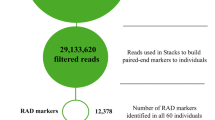Abstract
This paper describes genetic markers which can be used to study selection and genetic adaptation of organisms to radionuclide and other types of contaminant stress. Previous research using the randomly amplified polymorphic DNA (RAPD) technique has identified several markers which revealed genetic differences between contaminated and reference western mosquitofish (Gambusia affinis) populations. Experimental evidence suggested that these markers may be associated with loci involved in determining relative fitness in radionuclide-contaminated environments (“contaminant-indicative markers”). In the present study, Southern blot analyses show these markers to be highly conserved in DNA sequence and molecular length in sea urchins, mosquitofish, herring gulls and humans. Such conservation is thought to be rare among RAPD bands. Results of DNA sequencing efforts did not provide definitive evidence as to the identity of these loci, but indicated that short segments (<40bp) of known DNA sequences were homologous to various regions of the RAPD sequences. Furthermore, the regions of homology seemed to be non-randomly distributed along the length of the RAPD markers. Although the identity of these bands is still unknown, the high degree of conservatism suggests that these loci might play an important role in molecular processes.
Similar content being viewed by others
References
Bardakci, F.and Skibinski, D.O.F.(1994).Application of the RAPD technique in tilapia sh:species and subspecies identification.Heredity 73, 117–23.
Dinesh, K.R, Lim, T.M., Chua, K.L., Chan, W.K.and Phang, V.P.E.(1993).RAPD analysis:an efficient method of DNA ngerprinting in fishes. Zool.Sci. 10, 849–54.
Espinasa, L.and Borowsky, R.(1998).Evolutionary divergence of AP-PCR (RAPD)patterns.Mol.Biol.Evol.15, 408–14.
Hadrys, H., Balick, M.and Schierwater, B.(1992).Applications of random amplified polymorphic DNA (RAPD)in molecular ecology.Mol.Ecol. 1, 55–63.
Hedrick, P.(1992).Shooting the RAPDs.Nature 355, 679–80.
Jun, J.H., Chung, K.H., Jeong, S.B.and Lee, H.J.(2002). Identification of RAPD and SCAR markers linked to the flesh adhesion gene F in peach (Prunus persica (L.)Batsch) J.Hortic.Sci.Biotechnol. 77, 598–603.
Kuusipalo, L.(1994).Assessing Genetic Structure of Pelagic Fish Populations of Lake Tanganyika (in French). Bujumbura,Burundi: Bujumbura-Burundi FAO.
Naish, K.A., Warren, M., Bardakci, F., Skibinski, D.O.F., Carvalho, G.R.and Mair, G.C.(1995).Multilocus DNA ngerprinting and RAPD reveal similar genetic relation-ships between strains of Oreochromis niloticus (Pisces:Cic-hlidae).Mol.Ecol. 4, 271–4.
Paran, I.and Michelmore, R.W.(1993).Development of reliable pcr-based markers linked to downy mildew resistance genes in lettuce.Theor.Appl.Genet.85, 985–93.
Polashock, J.J.and Vorsa, N.(2002).Development of SCAR markers for DNA ngerprinting and germplasm analysis of American Cranberry.J.Am.Soc.Hort.Sci. 127, 677–84.
Postlethwait, J.H., Johnson, S.L., Midson, C.N., Talbot, W.S. and Gates, M.(1994).A genetic linkage map for the zebra fish.Science 264, 699–703.
Sambrook, J, Fritsch, E.F.and Maniatis, T.(1989).Molecular Cloning:A Laboratory Manual.New York: Cold Spring Harbor Press.
Theodorakis, C.W.and Shugart, L.R.(1997).Genetic ecotoxicology II:population genetic structure in radionu-clide-contaminated mosquito fish (Gambusia affinis). Ecotoxicology 6, 335–54.
Theodorakis, C.W.and Shugart, L.R.(1998).Genetic ecotox-icology III:the relationship between DNA strand breaks and genotype in mosquito fish exposed to radiation.Eco-toxicology 7, 227–36.
Theodorakis, C.W., Elbl, T.and Shugart, L.R.(1999).Genetic ecotoxicology IV:survival and DNA strand breakage is dependant on genotype in radionuclide-exposed mosquito-fish.Aquat.Toxicol.45, 279–91.
Theodorakis, C.W., Bickham, J.W., Elbl, T., Shugart, L.R.and Chesser, R.K.(1998).Genetics of radionuclide-contaminated mosquito fish populations and homology between Gambu-sia affinis and G.holbrooki.Environ.Toxicol.Chem.10, 1992–8.
Yau, F.C.F., Wong, K.L., Wang J., But, P.P.H.and Shaw, P.C. (2002).Generation of a sequence characterized amplified region probe for authentication of crocodilian species source.J.Exp.Zool. 294, 382–6.
Zhou, L., Wang, Y.and Gui, J.F.(2001).Molecular analysis of silver crucian carp (Carassius auratus gibelio Bloch)clones by SCAR markers.Aquaculture 201, 219–28.
Author information
Authors and Affiliations
Rights and permissions
About this article
Cite this article
Theodorakis, C.W., Bickham, J.W. Molecular Characterization of Contaminant-Indicative RAPD Markers. Ecotoxicology 13, 303–309 (2004). https://doi.org/10.1023/B:ECTX.0000033088.68427.59
Issue Date:
DOI: https://doi.org/10.1023/B:ECTX.0000033088.68427.59



